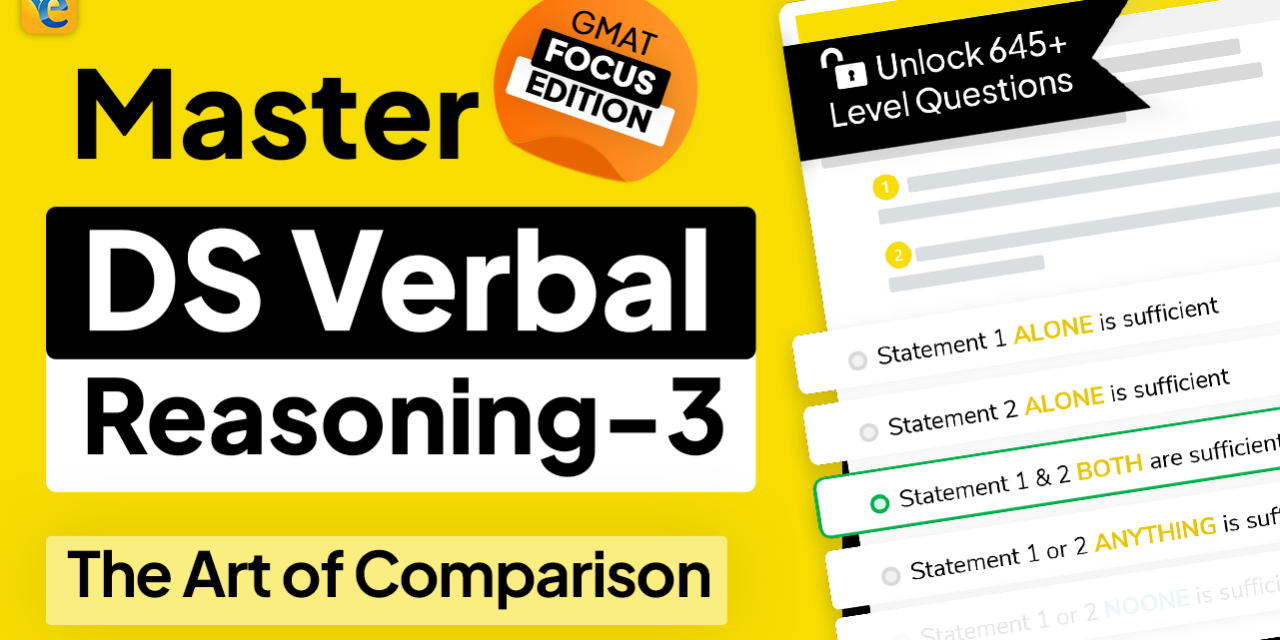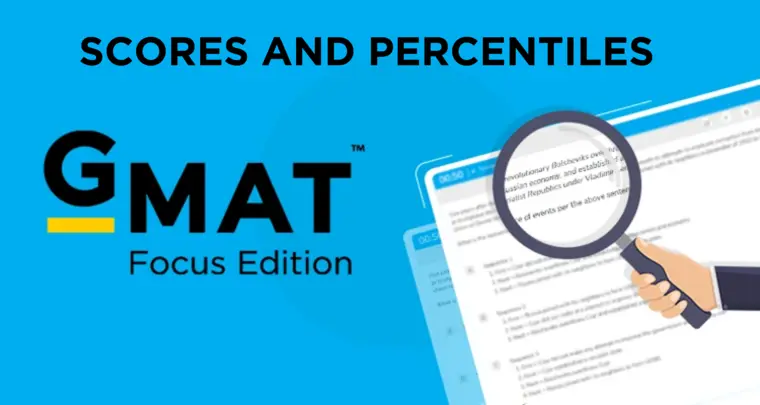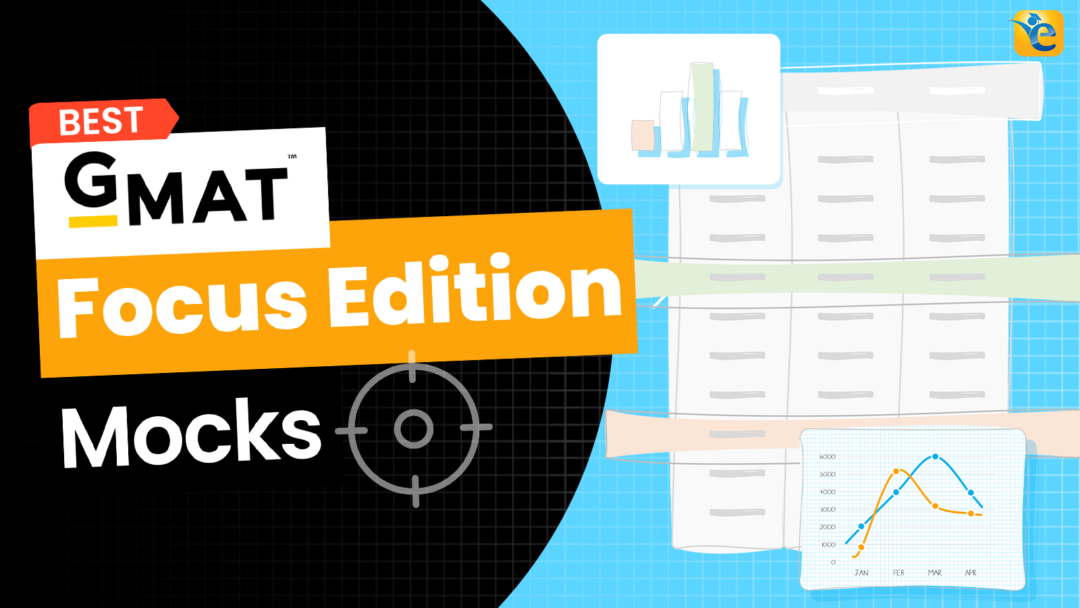Introduction
The brand-new Data Sufficiency Verbal Reasoning questions have taken comparisons to another level. Solve this 645+ level official question with us in this article and appreciate the beauty of the process of exploring comparison that enables students to answer such questions with utmost ease!
Our goal with this article series is simple – equip you with the process that you can use to solve all varieties of verbal reasoning DS questions with confidence!
You may read below articles in this series:
And the best part – you don’t need to learn any additional concepts. You just need to sharpen your analytical abilities and inference drawing skills – true life skills that will be beneficial through and through!
Let’s get started.
Start your GMAT Focus journey with our free GMAT Focus mock test to gauge your baseline score, and then create a personalized study plan. Dive into our free trial for targeted prep. Trusted by thousands with 2600+ reviews on GMAT Club, e-GMAT is your partner in mastering the GMAT. Contact us at support@e-gmat.com for expert guidance.
Exploring Comparisons
Question (Data Sufficiency – Exploring Comparisons)
Here is a Difficult 645+ Level Official question.
Five coffee-chicory blends—J, K, L, M, and N—are all priced differently. The blends are such that the greater the proportion of coffee, the more expensive the blend—and the greater the proportion of chicory, the stronger the flavor of the blend. If the five blends were ranked in order of cost per kilogram, which would fall in the middle?
(1) Blend L has a higher proportion of coffee than the other blends, except for Blend M.
(2) Blend K and Blend N both have a stronger flavor than Blend J.
Step-by-Step Solution
Watch this video to see the solution of the above question in the video format:
Here is the step-by step solution:
Step 1: Own the dataset
Translate the dataset
- Five coffee blends – Each contains chicory + coffee
- More coffee ➡️ higher price
- More chicory ➡️ stronger flavor
Question asks – which blend has price in the middle?
With these notes, are we ready to move to the statements? Absolutely not. This is just the translation of the passage. We have not as yet engaged with this information to draw inferences.
Draw Inferences
See, we have two relationships given:
- Coffee with price
- Chicory with flavor
And the question is asking about the ranking of price. If the statements provide information about coffee, then we can infer about price. But if we have any information about chicory, can we conclude anything about the price? Or is it just the flavor that we can conclude upon?
We can definitely conclude about the price even with chicory information and that is because the blend contains two things – coffee and chicory. So, if we know chicory quantity, then we will know coffee as well.
So, here is an additional inference:
- Chicory more ➡️ coffee less ➡️ price less
In fact, we can draw one more inference:
- Flavor more ➡️ chicory more ➡️ coffee less ➡️ price less.
So, you can see how we have gone from just one quantity linked with price to both quantities linked with price. Such is the power of drawing inferences. Now let’s visualize the approach.
Want to know where you stand on the GMAT Focus? Take our free GFE mock test and identify your baseline score. Get valuable insights into your performance, identify your strengths and weaknesses, and make an informed decision about your preparation path.
Step 2: Visualize the Approach.
To find the coffee blend that has price in the middle, we should visualize the pricing of the 5 blends on a number line. We should analyze the information presented in the statements, draw inferences, and place the pricing of the coffee blends on a number line.
So, with this information, we are ready to move to step 3.
Step 3: Execute the approach
Analyze Statement 1:
Blend L has a higher proportion of coffee than the other blends except for Blend M.
- Coffee Quantity comparison
- L > J / K / N
- M > L
- Thus, price also follows the same relationship.

The question asked us which one is in the middle. Any one of J,K, or N can be at the middle.
Thus, this statement is not sufficient and hence choices AD are eliminated.
Analyze Statement 2:
Blend K and Blend N both have a stronger flavor than Blend J.
- Flavor comparison: K and N > J
- Since flavor more ➡️ price less
- Price comparison: J > K and N

The question asked us which one is in the middle. Since we do not know the placement of L and M, we cannot say which one is in the middle.
Thus, Statement 2 is also not sufficient.
Hence choice B is also eliminated and now we are left with choice CE.
Analyze statements 1 and 2 together
Now let’s combine the two number lines and see if can find the middle value.


See how statement 1 provided placement of L and M, something that we were missing when we analyzed statement 2. And hence we can now clearly see that J is at the middle.
Thus, the correct answer is choice C.
Potential Faltering Points
- If you answered this question correctly but were not confident about your approach, then most likely you did not draw the inferences that you should have.
- Corrective Action: Pause for 10-15 second after translating the question and force yourself to think about inferences before you look at the statements.
- If you selected choice B as the correct answer, then you faltered because you brought the information from statement 1 while analyzing statement 2.
- Corrective Action: Master the process of solving DS questions.
- E-GMAT students master this process through two purpose-built modules before they come to the module of verbal reasoning.

Summary (Data Sufficiency – Exploring Comparisons)
Let’s summarize the salient features of this question.
- Our approach
- Extracted the passage in our notes
- Drew inferences before adding any new information from the statements
- Visualized the quantities on a number line
- Executed the DS approach
- Observations
- We did not refer to the passage once we took notes.
- We did not waste any time while analyzing the statements since we had such solid understanding of the relationships between various information with price.
PRACTICE QUESTIONS
Version 1: Final Question asked has changed. Everything else is the same.
Five coffee-chicory blends—J, K, L, M, and N—are all priced differently. The blends are such that the greater the proportion of coffee, the more expensive the blend—and the greater the proportion of chicory, the stronger the flavor of the blend. Which blend is the second most expensive?
(1) Blend L has a higher proportion of coffee than the other blends, except for Blend M.
(2) Blend K and Blend N both have a stronger flavor than Blend J.
Version 2: All parts of the question have been modified
Five coffee-chicory blends—J, K, L, M, and N—are all priced differently. The blends are such that the greater the proportion of coffee, the more expensive the blend—and the greater the proportion of chicory, the stronger the flavor of the blend. Which blend has the strongest flavor?
(1) Blend L is more expensive than Blend J but less expensive than Blend M.
(2) Blend N has a lower proportion of coffee than the other blends, except for Blend K.
Ready to tackle the GMAT Focus Edition? e-GMAT offers a Personalized Study Planner and top-notch Free GFE mock exam to help you prepare effectively. As the most reviewed GMAT prep company on GMAT Club with 2600+ reviews we’re here to support your GMAT Focus journey. Take advantage of our free trial with the best quality content. Start your path to success today!
CHEAT SHEET FOR PRACTICE QUESTIONS
Version 1
Analyze Statement 1:
Blend L has a higher proportion of coffee than the other blends except for Blend M.
- Coffee Quantity comparison
- L > J / K / N
- M > L
- Thus, price also follows the same relationship.

The question asked us which one is the second least expensive. Any one of J,K, or N can be at that position.
Thus, this statement is not sufficient and hence choices AD are eliminated.
Analyze Statement 2 :
Blend K and Blend N both have a stronger flavor than Blend J.
- Flavor comparison: K and N > J
- Since flavor more ➡️ price less
- Price comparison: J > K and N

The question asked us which one is the second least expensive. Since we do not know the placement of L and M, we cannot say which one is in that position.
Thus, Statement 2 is also not sufficient.
Hence choice B is also eliminated and now we are left with choice CE.
Analyze statements 1 and 2 together
Now let’s combine the two number lines and see if can find the middle value.


Even with the statements combined, we can only say that the second most expensive is either K or N.
Thus, the correct answer is choice E.
Version 2
Approach:
Strongest Flavor = Most Chicory = Least Coffee = Least Expensive
So, we want the least expensive blend.
Analyze Statement 1:
Blend L is more expensive than Blend J but less expensive than Blend M.
- Price comparison (and hence, coffee)
- L > J
- L < M
- Chicory and hence, flavor, follows the reverse relationship.

We need the least expensive blend. But we have no idea about blends K and N. Any one of J,K, or N can be the least expensive.
Thus, this statement is not sufficient and hence choices AD are eliminated.
Analyze Statement 2 :
Blend N has a lower proportion of coffee than the other blends, except for Blend K.
- Coffee comparison (and hence, price)
- N > K
- N < JLM

From this number line, it is clear that K is the least expensive blend.
Thus, Statement 2 is sufficient alone.
Thus, the correct answer is choice B.
Ready to tackle the GMAT Focus Edition? e-GMAT offers a Personalized Study Planner and top-notch Free GFE mock exam to help you prepare effectively. As the most reviewed GMAT prep company on GMAT Club with 2600+ reviews we’re here to support your GMAT Focus journey. Take advantage of our free trial with the best quality content. Start your path to success today!













